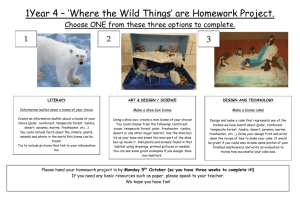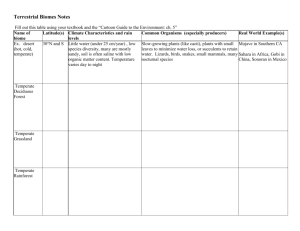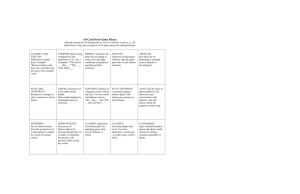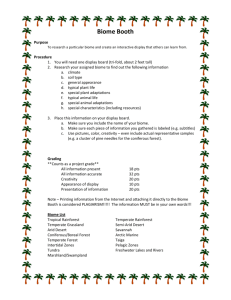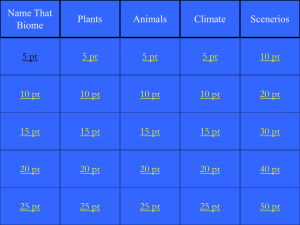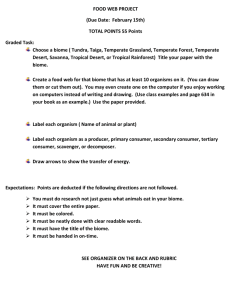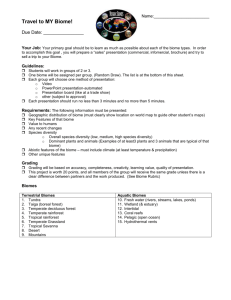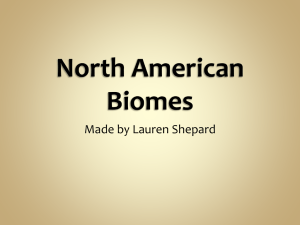File - Ms. zabel`s Classroom
advertisement
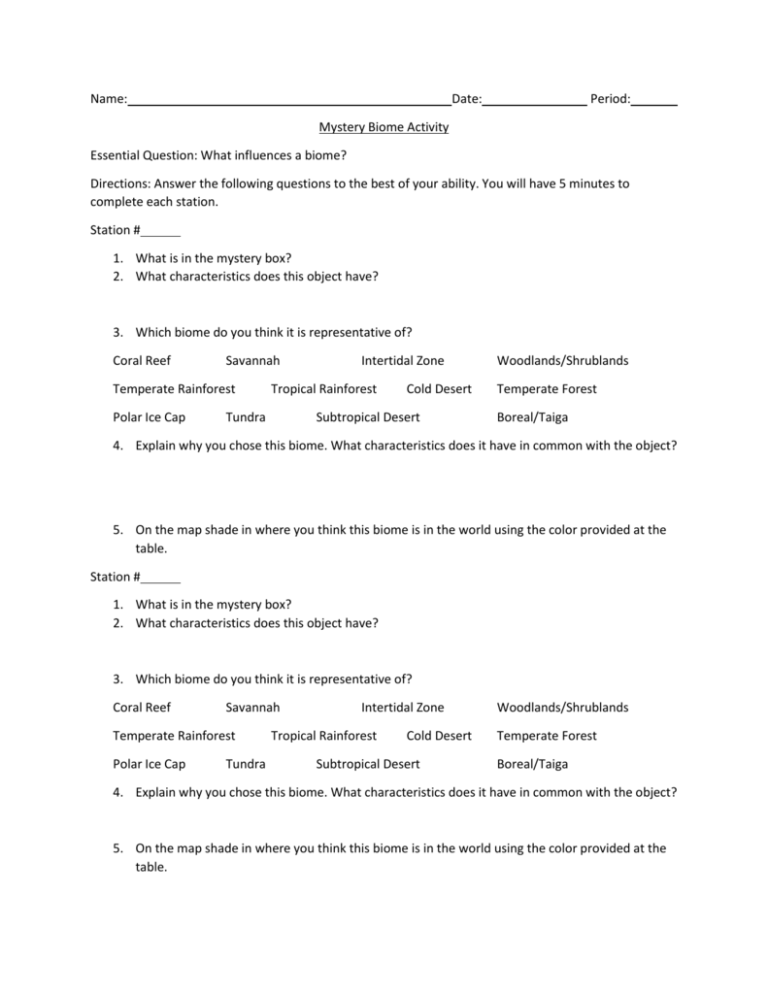
Name: Date: Period: Mystery Biome Activity Essential Question: What influences a biome? Directions: Answer the following questions to the best of your ability. You will have 5 minutes to complete each station. Station # 1. What is in the mystery box? 2. What characteristics does this object have? 3. Which biome do you think it is representative of? Coral Reef Savannah Temperate Rainforest Polar Ice Cap Intertidal Zone Tropical Rainforest Tundra Cold Desert Subtropical Desert Woodlands/Shrublands Temperate Forest Boreal/Taiga 4. Explain why you chose this biome. What characteristics does it have in common with the object? 5. On the map shade in where you think this biome is in the world using the color provided at the table. Station # 1. What is in the mystery box? 2. What characteristics does this object have? 3. Which biome do you think it is representative of? Coral Reef Savannah Temperate Rainforest Polar Ice Cap Tundra Intertidal Zone Tropical Rainforest Cold Desert Subtropical Desert Woodlands/Shrublands Temperate Forest Boreal/Taiga 4. Explain why you chose this biome. What characteristics does it have in common with the object? 5. On the map shade in where you think this biome is in the world using the color provided at the table. Station # 1. What is in the mystery box? 2. What characteristics does this object have? 3. Which biome do you think it is representative of? Coral Reef Savannah Temperate Rainforest Polar Ice Cap Intertidal Zone Tropical Rainforest Tundra Cold Desert Subtropical Desert Woodlands/Shrublands Temperate Forest Boreal/Taiga 4. Explain why you chose this biome. What characteristics does it have in common with the object? 5. On the map shade in where you think this biome is in the world using the color provided at the table. Station # 1. What is in the mystery box? 2. What characteristics does this object have? 3. Which biome do you think it is representative of? Coral Reef Savannah Temperate Rainforest Polar Ice Cap Tundra Intertidal Zone Tropical Rainforest Cold Desert Subtropical Desert Woodlands/Shrublands Temperate Forest Boreal/Taiga 4. Explain why you chose this biome. What characteristics does it have in common with the object? 5. On the map shade in where you think this biome is in the world using the color provided at the table. Station # 1. What is in the mystery box? 2. What characteristics does this object have? 3. Which biome do you think it is representative of? Coral Reef Savannah Temperate Rainforest Polar Ice Cap Intertidal Zone Tropical Rainforest Tundra Cold Desert Subtropical Desert Woodlands/Shrublands Temperate Forest Boreal/Taiga 4. Explain why you chose this biome. What characteristics does it have in common with the object? 5. On the map shade in where you think this biome is in the world using the color provided at the table. Station # 1. What is in the mystery box? 2. What characteristics does this object have? 3. Which biome do you think it is representative of? Coral Reef Savannah Temperate Rainforest Polar Ice Cap Tundra Intertidal Zone Tropical Rainforest Cold Desert Subtropical Desert Woodlands/Shrublands Temperate Forest Boreal/Taiga 4. Explain why you chose this biome. What characteristics does it have in common with the object? 5. On the map shade in where you think this biome is in the world using the color provided at the table. Station # 1. What is in the mystery box? 2. What characteristics does this object have? 3. Which biome do you think it is representative of? Coral Reef Savannah Temperate Rainforest Polar Ice Cap Intertidal Zone Tropical Rainforest Tundra Cold Desert Subtropical Desert Woodlands/Shrublands Temperate Forest Boreal/Taiga 4. Explain why you chose this biome. What characteristics does it have in common with the object? 5. On the map shade in where you think this biome is in the world using the color provided at the table. Station # 1. What is in the mystery box? 2. What characteristics does this object have? 3. Which biome do you think it is representative of? Coral Reef Savannah Temperate Rainforest Polar Ice Cap Tundra Intertidal Zone Tropical Rainforest Cold Desert Subtropical Desert Woodlands/Shrublands Temperate Forest Boreal/Taiga 4. Explain why you chose this biome. What characteristics does it have in common with the object? 5. On the map shade in where you think this biome is in the world using the color provided at the table. Station # 1. What is in the mystery box? 2. What characteristics does this object have? 3. Which biome do you think it is representative of? Coral Reef Savannah Temperate Rainforest Polar Ice Cap Intertidal Zone Tropical Rainforest Tundra Cold Desert Subtropical Desert Woodlands/Shrublands Temperate Forest Boreal/Taiga 4. Explain why you chose this biome. What characteristics does it have in common with the object? 5. On the map shade in where you think this biome is in the world using the color provided at the table. Station # 1. What is in the mystery box? 2. What characteristics does this object have? 3. Which biome do you think it is representative of? Coral Reef Savannah Temperate Rainforest Polar Ice Cap Tundra Intertidal Zone Tropical Rainforest Cold Desert Subtropical Desert Woodlands/Shrublands Temperate Forest Boreal/Taiga 4. Explain why you chose this biome. What characteristics does it have in common with the object? 5. On the map shade in where you think this biome is in the world using the color provided at the table. Station # 1. What is in the mystery box? 2. What characteristics does this object have? 3. Which biome do you think it is representative of? Coral Reef Savannah Temperate Rainforest Polar Ice Cap Intertidal Zone Tropical Rainforest Tundra Cold Desert Subtropical Desert Woodlands/Shrublands Temperate Forest Boreal/Taiga 4. Explain why you chose this biome. What characteristics does it have in common with the object? 5. On the map shade in where you think this biome is in the world using the color provided at the table. Station # 1. What is in the mystery box? 2. What characteristics does this object have? 3. Which biome do you think it is representative of? Coral Reef Savannah Temperate Rainforest Polar Ice Cap Tundra Intertidal Zone Tropical Rainforest Cold Desert Subtropical Desert Woodlands/Shrublands Temperate Forest Boreal/Taiga 4. Explain why you chose this biome. What characteristics does it have in common with the object? 5. On the map shade in where you think this biome is in the world using the color provided at the table. Warm Up: Answer each multiple choice question to the best of your ability. The following choices are for questions 1-4 and refer to plant adaptations found in the biome. a. b. c. d. e. Desert Tundra Boreal forest Temperate forest Tropical rain forest 1. 2. 3. 4. 5. Plants adapted for shallow nutrient poor soil; have buttresses Plants adapted for lack of water availability in winter; deciduous Plants adapted to short growing season; have needles to decrease transpiration in cold climate Plants take in CO2 at night to reduce water loss; have needles; stem photosynthesis The biome not found in the southern hemisphere is the a. Desert b. Taiga c. Temperate grassland d. Temperate rainforest e. Tropical rainforest Warm Up: Answer each multiple choice question to the best of your ability. The following choices are for questions 1-4 and refer to plant adaptations found in the biome. a. b. c. d. e. Desert Tundra Boreal forest Temperate forest Tropical rain forest 1. 2. 3. 4. 5. Plants adapted for shallow nutrient poor soil; have buttresses Plants adapted for lack of water availability in winter; deciduous Plants adapted to short growing season; have needles to decrease transpiration in cold climate Plants take in CO2 at night to reduce water loss; have needles; stem photosynthesis The biome not found in the southern hemisphere is the a. Desert b. Taiga c. Temperate grassland d. Temperate rainforest e. Tropical rainforest Name: 1. Two of the most important factors that determine a climate are a. Latitude and precipitation b. Temperature and precipitation c. The animals and plants that live there d. Latitude and altitude 2. Tropical rain forests a. Have deep, nutrient-rich soils b. Have deep, nutrient-poor soils c. Have shallow, nutrient-rich soils d. Have shallow, nutrient-poor soils e. Have a widely distributed soil pattern 3. A cattle egret standing on the back of a cow is an example of a. Mutualism b. Parasitism c. A predator-prey relationship d. Commensalism e. Eutrophication 4. What biome would be most affected by a large decrease in precipitation? a. Desert b. Tundra c. Coniferous forest d. Temperate forest e. Grassland 5. If you travel south from Canada to Costa Rica, you would pass through several biomes. This change in biomes is mainly the result of a. Altitude b. Human factors c. Increase in temperature and precipitation d. Ocean currents e. succession
